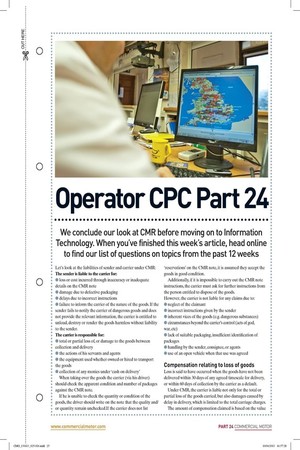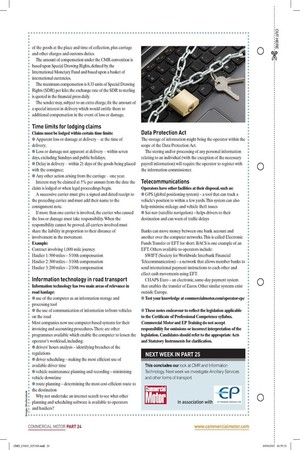Operator CPC Part 24 We conclude our look at CMR
Page 17

Page 18

If you've noticed an error in this article please click here to report it so we can fix it.
before moving on to Information Technology. When you've finished this week's article, head online to find our list of questions on topics from the past 12 weeks Let's look at the liabilities of sender and carrier under CMR: The sender is liable to the carrier for: • loss or cost incurred through inaccuracy or inadequate details on the CMR note • damage due to defective packaging • delays due to incorrect instructions • failure to inform the carrier of the nature of the goods. If the sender fails to notify the carrier of dangerous goods and does not provide the relevant information, the carrier is entitled to unload, destroy or render the goods harmless without liability to the sender.
The carrier is responsible for: • total or partial loss of, or damage to the goods between collection and delivery • the actions of his servants and agents • the equipment used whether owned or hired to transport the goods • collection of any monies under 'cash on delivery' When taking over the goods the carrier (via his driver) should check the apparent condition and number of packages against the CMR note.
If he is unable to check the quantity or condition of the goods, the driver should write on the note that the quality and/ or quantity remain unchecked.If the carrier does not list 'reservations' on the CMR note, it is assumed they accept the goods in good condition.
Additionally, if it is impossible to carry out the CMR note instructions, the carrier must ask for further instructions from the person entitled to dispose of the goods.
However, the carrier is not liable for any claims due to: • neglect of the claimant • incorrect instructions given by the sender • inherent vices of the goods (e.g. dangerous substances) • circumstances beyond the carrier's control (acts of god, war, etc) • lack of suitable packaging, insufficient identification of packages • handling by the sender, consignee, or agents • use of an open vehicle when that use was agreed Compensation relating to loss of goods Loss is said to have occurred when the goods have not been delivered within 30 days of any agreed timescale for delivery, or within 60 days of collection by the carrier as a default.
Under CMR, the carrier is liable not only for the total or partial loss of the goods carried, but also damages caused by delay in delivery, which is limited to the total carriage charges.
The amount of compensation claimed is based on the value of the goods at the place and time of collection, plus carriage and other charges and customs duties.
The amount of compensation under the CMR convention is based upon Special Drawing Rights, defined by the International Monetary Fund and based upon a basket of international currencies.
The maximum compensation is 8.33 units of Special Drawing Rights (SDR) per kilo; the exchange rate of the SDR to sterling is quoted in the financial press daily.
The sender may, subject to an extra charge, fix the amount of a special interest in delivery which would entitle them to additional compensation in the event of loss or damage.
Time limits for lodging claims Claims must be lodged within certain time limits: • Apparent loss or damage at delivery — at the time of delivery; • Loss or damage not apparent at delivery — within seven days, excluding Sundays and public holidays; • Delay in delivery — within 21 days of the goods being placed with the consignee; • Any other action arising from the carriage — one year. Interest may be claimed at 5% per annum from the date the claim is lodged or when legal proceedings begin.
A successive carrier must give a signed and dated receipt to the preceding carrier and must add their name to the consignment note.
If more than one carrier is involved, the carrier who caused the loss or damage must take responsibility. When the responsibility cannot be proved, all carriers involved must share the liability in proportion to their distance of involvement in the movement.
Example: Contract involving 1,000-mile journey Haulier 1:500 miles — 5/10th compensation Haulier 2:300 miles — 3/10th compensation Haulier 3:200 miles — 2/10th compensation Information technology in road transport Information technology has two main areas of relevance in road haulage: • use of the computer as an information storage and processing tool • the use of communication of information to/from vehicles on the road Most companies now use computer-based systems for their invoicing and accounting procedures. There are other programmes available which enable the computer to lessen the operator's workload, including: • drivers' hours analysis — identifying breaches of the regulations • driver scheduling — making the most efficient use of available driver time • vehicle maintenance planning and recording — minimising vehicle downtime • route planning — determining the most cost-efficient route to the destination Why not undertake an internet search to see what other planning and scheduling software is available to operators and hauliers? Data Protection Act The storage of information might bring the operator within the scope of the Data Protection Act.
The storing and/or processing of any personal information relating to an individual (with the exception of the necessary payroll information) will require the operator to register with the information commissioner.
Telecommunications Operators have other facffifies at their disposal, such as: • GPS (global positioning system) — a tool that can track a vehicle's position to within a few yards. This system can also help minimise mileage and vehicle theft issues • Sat-nay (satellite navigation) — helps drivers to their destination and can warn of traffic delays Banks can move money between one bank account and another over the computer networks. This is called Electronic Funds Transfer or EFT for short. BACS is one example of an EFT. Others available to operators include: SWIFT (Society for Worldwide Interbank Financial Telecommunication) — a network that allows member banks to send international payment instructions to each other and effect cash movements using EFT.
CHAPS Euro — an electronic, same-day payment system that enables the transfer of Euros. Other similar systems exist outside Europe.
• Test your knowledge at conunercialmotor.com/operator-cpc • These notes endeavour to reflect the legislation applicable to the Certificate of Professional Competence syllabus. Commercial Motor and EP Training do not accept responsibility for omissions or incorrect interpretation of the legislation. Candidates should refer to the appropriate Acts and Statutory Instruments for clarification.







































